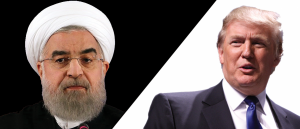KNOW
September 26, 2019
Tensions between the United States and the Middle East have been high for decades, particularly since the attacks on Sept. 11 in 2001. However, in the last year, our current President has caused a rise in issues with our political and economic relations with Iran.
Since the beginning of the conflict with President Trump and Iran, here is a timeline of events including information from Vox, the Washington Post, the Times of Israel, Newsweek, USA Today, and the Independent:
In 2018, President Trump backed out of the Iran Nuclear Deal and began pushing Iran to stop working with other countries and their nuclear program all together. Shortly after, the administration placed sanctions on Iran, focused on harming the Iranian economy. This lasted for several months without another major step taken from either side.
Following the sanctions in 2018, Trump deemed the Iranian government’s military as a terrorist group. In response, Iran declares the U.S. military as a terrorist group as well. Not even a month later, the Trump Administration ends waivers that protected other countries from U.S. sanctions on oil, meaning that other countries were subject to the sanctions from the United States and would be left to either hurt their economy or hurt Iran’s.
Three days after ending the waivers, the government sent aircraft carriers and bomber planes to the Persian Gulf, on the outside of Iran, and stated that they didn’t want a war but were “fully prepared to respond to any attack, whether by proxy, the Islamic Revolutionary Guard Corps, or regular Iranian forces.” Following more sanctions from the United States, Iran agrees to back down on some aspects of the nuclear deal almost a week later. Not even a week later, four oil tankers on the coast of the U.S. are attacked and the administration blamed Iran, but the Iranian government denied the allegations.
Almost two weeks thereafter, and nearing the end of May, Trump sends 1500 troops to Iran.
In June, four oil tankers on the coast of the United States are attacked again, in the same area. Iran was blamed for this attack once again, and denied the accusations.
Approximately a week later, Iran announces that they’ve almost reached the limit of stock-piled uranium they could have, and state that if the other countries in the deal could help, then the deal could go back to its original terms. The same day, Trump sends another 1000 troops to Iran.
Iran proceeded to shoot down an unmanned drone that belonged to the U.S. that was in Iran. Trump attempts to retaliate by planning a strike, but claimed he called it off ten minutes before to avoid the casualties that weren’t “proportionate to shooting down an unmanned drone”. Instead, the United States proceeds with cyberattacks on Iran.
In July, the other countries in the Iran Nuclear Deal didn’t help ease the pressure on Iran from the United States, and more sanctions are placed by the administration.
At the end of August, Trump discussed having a meeting with Iran’s President, but that still hasn’t occurred. However, at the most recent conference for the Group of Seven, Trump lightened up on Iran.
Following all these events, Trump tweeted out a secure image from Iran stating: “The United States of America was not involved in the catastrophic accident during final launch preparations for the Safir [Space Launch Vehicle] Launch at Semnan Launch Site One in Iran. I wish Iran best wishes and good luck in determining what happened at Site One.” In the image, there is a highly detailed depiction of the launch failure that occurred in Iran the day before that experts suspect came from a drone, according to NPR.
Since the resignation of John Bolton, President Trump’s National Security Advisor, some believe that tensions with Iran could begin to decline, as many hold him responsible for some of the actions that the Trump Administration took against Iran, according to Quartz. Alex Vatanka, a senior fellow at the Middle East Institute, told Quartz that it’s not clear that Trump necessarily wanted anymore conflict with Iran besides limited their supply of nuclear weapons. Iran’s officials have made it clear that if Trump wanted to discuss relations that Bolton would have to go.
Because of recent changes, it is unclear how Iran will respond.



